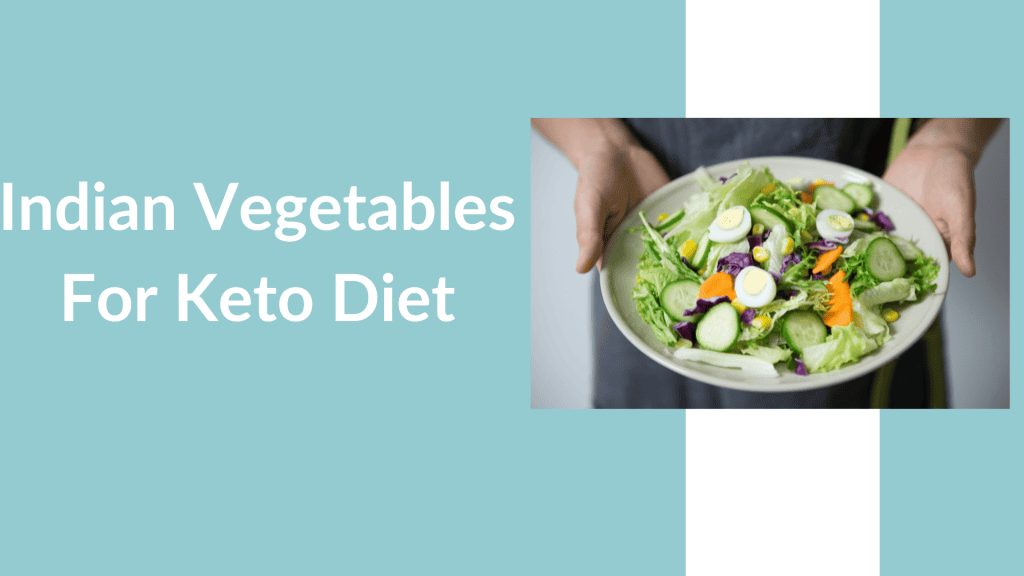Vegetables, particularly those commonly used in Indian cuisine, are integral to the ketogenic diet, offering vital nutrients while maintaining a low carbohydrate profile. Staples of Indian cooking such as spinach, fenugreek leaves (also known as methi), bottle gourd (lauki), bitter gourd (karela), cauliflower, and cabbage are not only low in carbohydrates but also rich in fiber, vitamins, and minerals.
In addition to these, other Indian vegetables like okra (bhindi), eggplant (baingan), and ridge gourd (turai) can also be incorporated into a keto diet. These vegetables are not only flavorful but also packed with nutrients and low in carbs. Thus, a well-planned keto diet with a variety of Indian vegetables can be both delicious and nutritionally balanced.
Top 10 Indian Vegetables for Keto Diet
The veggies you eat play a crucial role in a successful low-carb lifestyle, so try to adhere to this keto vegetable list. These vegetables are loaded with fiber content and have various health benefits too, apart from its benefit as a part of keto diet these vegetables for weight loss can also be included in other diet plans.
- Spinach (Palak): 1.4 grams of carbs per 100 grams
- Cauliflower (Phool Gobi): 3 grams of carbs per 100 grams
- Broccoli (Hari Phool Gobi): 6 grams of carbs per 100 grams
- Bitter Gourd (Karela): 4 grams of carbs per 100 grams
- Zucchini (Jhinga): 3 grams of carbs per 100 grams
- Bell Peppers (Shimla Mirch): 6 grams of carbs per 100 grams
- Brussels Sprouts (Chhoti Gobhi): 5 grams of carbs per 100 grams
- Cabbage (Patta Gobi): 5 grams of carbs per 100 grams
- Asparagus (Shatavari): 3 grams of carbs per 100 grams
- Mushrooms (Khumb): 3 grams of carbs per 100 grams
1. Spinach (Palak): 1.4 grams of carbs per 100 grams
Spinach is a great addition to a keto diet due to its low carbohydrate content and high nutrient density. Spinach is packed with vitamins and minerals, including vitamin A and C, which are known for their antioxidant properties and immune-boosting benefits. Additionally, it is a good source of iron, a mineral essential for producing red blood cells and transporting oxygen throughout the body. It also contains calcium, which is crucial for bone health and muscle function.
2. Cauliflower (Phool Gobi): 3 grams of carbs per 100 grams
Cauliflower is an excellent addition to a keto diet as it aids in weight loss by improving metabolism and reducing fat deposition in the body. Plus, being low in calories and high in fiber, it can make you feel full, thereby reducing calorie intake.
In addition to these, Cauliflower is rich in various nutrients and antioxidants, which can contribute to overall health. It contains vitamins like vitamin C, which boosts the immune system, and vitamin K, which plays a role in bone health. It’s also a good source of folate and potassium.
3. Broccoli (Hari Phool Gobi): 6 grams of carbs per 100 grams
Broccoli is indeed keto-friendly. It is low in carbohydrates and high in fiber, making it an excellent choice for those following a ketogenic lifestyle. with only about 6 grams of carbs per 100 grams. This makes it suitable for a keto diet, which typically limits carb intake to under 50 grams per day. It is high in fiber, which can help promote feelings of fullness and improve digestive health. A 100-gram serving of broccoli contains about 2.6 grams of fiber.
4. Bitter Gourd (Karela): 4 grams of carbs per 100 grams
Bitter gourd is an excellent addition to a keto diet as it aids in weight loss by improving metabolism and reducing fat deposition in the body. Plus, being low in calories and high in fiber, it can make you feel full, thereby reducing calorie intake.
It’s not only low in calories but also high in dietary fiber, which can help you feel full and satisfied, reducing the overall calorie intake. This can be particularly beneficial for those aiming to lose weight. It contains certain enzymes that break down fat into free fatty acids, thereby helping in reducing body fat.
5. Zucchini (Jhinga): 3 grams of carbs per 100 grams
Zucchini is a low-carb vegetable, making it a great choice for those following a keto diet. It contains only 3 grams of carbs per 100 grams, making it an excellent option for those looking to keep their carb intake low.
Zucchini is also high in fiber, which can help promote feelings of fullness and improve digestive health. This can be particularly beneficial for those aiming to lose weight. It is high in water content, which can help keep you hydrated. Staying hydrated is crucial for overall health and can also aid in weight loss.
6. Bell Peppers (Shimla Mirch): 6 grams of carbs per 100 grams
Bell peppers are totally keto friendly! Carbs in bell peppers are low enough to enjoy frequently, although the exact macros vary by the colour you choose.
They also contain a decent amount of fiber, which helps reduce the net carb count.
Whether you choose green, red, yellow, or mini bell peppers, they all fit well within a ketogenic diet due to their low net carb content.
7. Brussels Sprouts (Chhoti Gobhi): 5 grams of carbs per 100 grams
Brussels sprouts are a great keto-friendly vegetable. One cup of raw Brussels sprouts contains approximately 7 grams of total carbs. After subtracting the fiber (which is essential for gut health), you’re left with just 3 grams of net carbs per cup. These low net carbs make Brussels sprouts an excellent choice for those following a keto diet. Brussels sprouts pack a punch when it comes to vitamins and minerals. They’re rich in vitamin K (important for bone health), vitamin C (an immune system booster), and folate (essential for cell division). Plus, they provide antioxidants that help protect your cells from damage.
9. Cabbage (Patta Gobi): 5 grams of carbs per 100 grams
Cabbage is low in calories and carbohydrates, making it a suitable choice for the keto diet. It is also rich in essential vitamins and minerals, including vitamin C, vitamin K, and potassium After accounting for the fiber (which is essential for gut health), the net carb count drops to a mere 2 grams per cup. This ultra-low carb content makes cabbage an excellent choice for keto enthusiasts. Despite its minimal caloric impact, cabbage is surprisingly nutrient-dense. It offers 42 percent of your daily vitamin C needs, along with trace amounts of iron, vitamin B6, and magnesium. The high-fiber nature of cabbage helps keep you satiated.
10. Asparagus (Shatavari): 3 grams of carbs per 100 grams
Half a cup (90 grams) of cooked asparagus contains approximately 1.9 grams of net carbs. With such minimal carbs, asparagus won’t disrupt your ketosis. Asparagus provides 2.2 grams of protein per half-cup serving. Protein is essential for maintaining muscle mass and overall health.
11. Mushrooms (Khumb): 3 grams of carbs per 100 grams
Mushrooms are not only low in carbs but are also a good source of fiber and essential vitamins, making them a great addition to your keto food list.
Mushrooms contain B vitamins like riboflavin (B2), niacin (B3), and pantothenic acid (B5), which play crucial roles in energy metabolism and overall health. They’re rich in minerals such as selenium, copper, and potassium. Mushrooms are a source of antioxidants that support a strong immune system. While not as protein-dense as meat, mushrooms still offer a modest amount of protein.
While we are making every effort to ensure that our keto diet remains as healthy as possible, one can only stop craving for tasty foods for so long, keeping that in mind, we have prepared a list of some keto options at Taco bell
Indian Vegetables to avoid in Keto Diet
When following a ketogenic diet, it’s important to be mindful of the vegetables you consume. Certain Indian vegetables are high in carbohydrates and should be avoided to maintain ketosis. These include potatoes, a staple in many Indian dishes, which are high in starch and carbs. Similarly, sweet potatoes and yams are also high in carbs. Other vegetables like peas, corn, and lentils are also not recommended due to their high carb content. Lastly, while carrots and beets are packed with nutrients, they are also higher in carbs compared to other vegetables and should be consumed in moderation. It is also worth noting that the oils you cook your vegetables in, here are the best oils for keto diet for your consideration Remember, the key to a successful keto diet is balancing your intake of proteins and fats while minimising your carbohydrate intake. Always consult with a healthcare professional or a dietitian before starting any new diet regimen.
- Potatoes (Aloo)
- Sweet Potatoes (Shakarkandi)
- Beets (Chukandar)
- Carrots (Gajar)
- Peas (Matar)
1. Potatoes (Aloo)
Potatoes are like a big energy pack filled with carbs. When you’re on a keto diet, you want to keep your carb intake low. Eating potatoes can quickly increase your carb intake and this can stop your body from staying in a state called ketosis, which is what you want when you’re on a keto diet.
2. Sweet Potatoes (Shakarkandi)
Sweet potatoes are a bit tricky. They are full of good stuff for your body, but they also have more carbs than other veggies. On a keto diet, you want to eat foods that are low in carbs, so sweet potatoes might not be the best choice.
3. Beets (Chukandar)
Beets are another vegetable that has a lot of good nutrients. But they also have sugars and carbs. If you eat a lot of beets, it can increase your carb intake and this can stop your body from staying in ketosis.
4. Carrots (Gajar)
Carrots have sugars and carbs. They are not as high as potatoes or sweet potatoes, but they still have more than other veggies. You can have carrots on a keto diet, but you should not eat too many.
5. Peas (Matar)
Peas are small but they pack a punch when it comes to carbs. They have more carbs than other non-starchy vegetables. So, they are not the best choice when you’re on a strict keto diet.
While we are talking about the keto diet for weight loss, you can read about keto diet to gain weight gain.
Expert Review on Indian Vegetables for Keto Diet
Dr. Ayush Gupta is a keto diet expert and believes that Indian vegetables offer a rich array of options for those following a Keto diet. From nutrient-dense leafy greens like spinach and fenugreek to low-carb staples like cauliflower and bottle gourd, these vegetables can be creatively incorporated into a variety of dishes. They not only help maintain the necessary balance of macronutrients required in a Keto diet but also provide essential vitamins and minerals. So, whether you’re making a spicy curry or a refreshing salad, Indian vegetables can make your Keto journey flavorful and healthful. Remember, it’s not just about cutting carbs, but making smart and nutritious choices. If you are confused as to which diet plans to follow, you can refer to our keto diet plan for better guidance.
References
Basciani, Sabrina, Elisabetta Camajani, Savina Contini, Agnese Persichetti, Renata Risi, Loris Bertoldi, Lidia Strigari, Giancarlo Prossomariti, Mikiko Watanabe, Stefania Mariani, et al. 2020. “Very-Low-Calorie Ketogenic Diets With Whey, Vegetable, or Animal Protein in Patients With Obesity: A Randomized Pilot Study.” The Journal of Clinical Endocrinology & Metabolism 105 (9): 2939–2949
Chauhan, Shailesh. 2024. “Exploring the Indian Vegetarian Version of the Keto Diet.” Medium
Unknown Author. 2023. “Vegetarian Keto Diet Plan for Indian: Download Free PDF.” HexaHealth
FAQs
1. What are the best Indian vegetables for keto?
Capsicums, cauliflower, spinach, zucchini, tomatoes, kale, cabbage, mint, bottle gourd (also known as lauki), bitter gourd (or Karela), coriander, okra (bhindi), mustard greens, eggplant (baingan), and broccoli are the best Indian vegetables for keto.
2. What vegetables are keto-friendly?
Arugula, asparagus, bell peppers, broccoli, Brussels sprouts, cauliflower, kale, mushrooms, spinach, and tomatoes are some keto friendly vegetables. If you’re following a ketogenic diet or contemplating starting one, there’s no need to restrict your vegetable intake. There are numerous vegetables that are low in carbohydrates and suitable for this diet.
3. Which vegetables are low carb in India?
Vegetables such as leafy greens like lettuce, along with cauliflower, cabbage, broccoli, and spinach, as well as zucchinis, eggplants (brinjals), cucumbers, carrots, mushrooms, onions, and tomatoes are all low in carbohydrates.
4. Is poha allowed in keto?
No, Poha, not to be confused with Pohe, is not a suitable choice for your Keto diet due to its high carbohydrate content. The Keto diet emphasizes low-carb, high-fat foods, and Poha doesn’t fit into this category.
Is Ladyfinger keto?
Okra, also widely recognized as Bhindi in numerous Indian households, is an excellent addition to the Keto diet. Its nutritional profile, characterized by a low carbohydrate content and a high fiber count, aligns perfectly with the dietary requirements of the Keto regimen.









